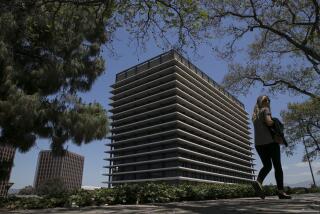DWP Buys Railroad That Would Serve Nevada Plant
ELY, Nev. — Deep in the Nevada desert, in a town in danger of becoming just another ghost town along a trail of abandoned copper mines, may lie the future of Los Angeles’ energy.
Coal energy, that is.
Just outside of this small community 282 miles north of Las Vegas, Los Angeles is proposing to build a coal-fired plant that would be one of several out-of-state Department of Water and Power power plants.
In anticipation of constructing the proposed White Pine power plant here, the DWP on Wednesday bought an 81-year-old, 128-mile railroad that would haul the coal a good part of the way from mines in nearby Utah or Wyoming. At a time when the city is struggling to build a multibillion-dollar subway, DWP officials flew a few hundred miles and easily snapped up a railroad--right-of-way, tracks and three locomotives--for $1 million.
As local plants age, places like Ely hold the future for the supply of a power-hungry Los Angeles Basin, according to DWP officials. Los Angeles, facing strict air quality requirements, needs controversy-free locations to produce additional electricity needed in the next 10 years. By the end of the 1990s, said Eldon Cotton, DWP assistant chief electrical engineer, increased demands on electricity will be as if a city the size of Indianapolis had been added to the Los Angeles Basin.
DWP officials are not guaranteeing that Ely will become the site of its next power plant. The $1-million purchase of the railroad to haul coal “is protecting our options. If it doesn’t work out we always have the option of selling it for scrap. But most likely, it’s not a question of if we build in Ely, it’s when we build in Ely,” said Norman E. Nichols, DWP assistant general manager in charge of power.
At the same time, officials here desperately need the jobs that a power plant would bring. Ely is still reeling from the effects of the 1983 shutdown of the nearby Kennecott Corp. copper smelting plant that was the biggest employer of the town’s 4,500 people. In an effort to revitalize their community, civic leaders have sought out projects that other communities would typically spurn. Ely business leaders “initially approached us about building a nuclear plant,” Cotton said. “We passed at that time, but we said we’d be interested in coal.”
And so it was with a collective sigh of relief for Ely and Los Angeles officials that the first step was taken Wednesday toward building the White Pine power plant.
Kennecott, which owned the Nevada North Railway, signed the line over to the DWP. The signing ceremony attracted more than 100 townspeople and Nevada’s governor, Richard Bryan, who arrived by train.
“This is an occasion to celebrate a community that has kept faith with itself,” Bryan said.
“This is salvation,” said Ely Councilwoman Dorothy Phillips. “We are broke. We need the industry.”
The $2.5-billion White Pine power plant project would employ 2,400 during construction and create about 500 permanent jobs, according to the DWP.
The Nevada Legislature passed special legislation that empowered White Pine County to issue tax-exempt bonds to finance the project and then sell the electricity to recoup costs. Fourteen utility companies would share the power. The DWP would receive a minimum of 40% of the electricity generated, with the remainder divided among eight Nevada utilities and Anaheim, Burbank, Glendale, Pasadena and Riverside. The proposed capacity of the plant is 1,500 megawatts produced by two steam-powered generators. Los Angeles’ minimum 40% share would be enough to supply power to 600,000 households, a DWP official said.
If it is built, the facility here would join a growing list of out-of-state plants from which the DWP has drawn significant power since 1967, Cotton said. Other plants include other coal-fueled facilities, such as the Intermountain Power Project near Delta, Utah.
As DWP plants in the Los Angeles area approach middle age, “we have to think about replacing the power that will be lost when they go and it’s virtually unthinkable of relocating in the metropolitan area,” Cotton said.
Local steam-generated power plants, some of which are 40 years old, emit sulfur dioxide and nitrous oxide. The plants currently comply with air quality standards, Cotton said, “but at some point we won’t be able to meet the standards. It’s like a 1955 Chevy having to meet new air quality standards. There’s only so much you can do to a unit that wasn’t built to accommodate future demands.”
More to Read
Inside the business of entertainment
The Wide Shot brings you news, analysis and insights on everything from streaming wars to production — and what it all means for the future.
You may occasionally receive promotional content from the Los Angeles Times.










